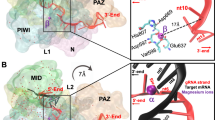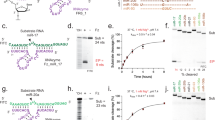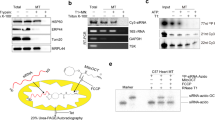Abstract
Short-interfering RNAs suppress gene expression through a highly regulated enzyme-mediated process called RNA interference (RNAi)1,2,3,4. RNAi involves multiple RNA-protein interactions characterized by four major steps: assembly of siRNA with the RNA-induced silencing complex (RISC), activation of the RISC, target recognition and target cleavage. These interactions may bias strand selection during siRNA-RISC assembly and activation, and contribute to the overall efficiency of RNAi5,6. To identify siRNA-specific features likely to contribute to efficient processing at each step, we performed a systematic analysis of 180 siRNAs targeting the mRNA of two genes. Eight characteristics associated with siRNA functionality were identified: low G/C content, a bias towards low internal stability at the sense strand 3′-terminus, lack of inverted repeats, and sense strand base preferences (positions 3, 10, 13 and 19). Further analyses revealed that application of an algorithm incorporating all eight criteria significantly improves potent siRNA selection. This highlights the utility of rational design for selecting potent siRNAs and facilitating functional gene knockdown studies.
This is a preview of subscription content, access via your institution
Access options
Subscribe to this journal
Receive 12 print issues and online access
$209.00 per year
only $17.42 per issue
Buy this article
- Purchase on Springer Link
- Instant access to full article PDF
Prices may be subject to local taxes which are calculated during checkout



Similar content being viewed by others
References
Sharp, P.A. RNA interference–2001. Genes Dev. 15, 485–490 (2001).
Bernstein, E., Caudy, A.A., Hammond, S.M. & Hannon, G.J. Role for a bidentate ribonuclease in the initiation step of RNA interference. Nature 409, 363–366 (2001).
Nykanen, A., Haley, B. & Zamore, P.D. ATP requirements and small interfering RNA structure in the RNA interference pathway. Cell 107, 309–321 (2001).
Elbashir, S.M., Lendeckel, W. & Tuschl, T. RNA interference is mediated by 21- and 22-nucleotide RNAs. Genes Dev. 15, 188–200 (2001).
Khvorova, A., Reynolds, A. & Jayasena, S. Functional siRNAs and miRNAs exhibit strand bias. Cell 115, 209–216 (2003).
Schwarz, D.S. et al. Unexpected asymmetry in the assembly of the RNAi enzyme complex. Cell 115, 199–208 (2003).
Elbashir, S.M., Harborth, J., Weber, K. & Tuschl, T. Analysis of gene function in somatic mammalian cells using small interfering RNAs. Methods 26, 199–213 (2002).
Holen, T., Amarzguioui, M., Wiiger, M.T., Babaie, E. & Prydz, H. Positional effects of short interfering RNAs targeting the human coagulation trigger Tissue Factor. Nucleic Acids Res. 30, 1757–1766 (2002).
Ding, Y. & Lawrence, C.E. Statistical prediction of single-stranded regions in RNA secondary structure and application to predicting effective antisense target sites and beyond. Nucleic Acids Res. 29, 1034–1046 (2001).
Kirchner, R., Vogtherr, M., Limmer, S. & Sprinzl, M. Secondary structure dimorphism and interconversion between hairpin and duplex form of oligoribonucleotides. Antisense Nucleic Acid Drug. Dev. 8, 507–516 (1998).
Groebe, D.R. & Uhlenbeck, O.C. Characterization of RNA hairpin loop stability. Nucleic Acids Res. 16, 11725–11735 (1988).
Groebe, D.R. & Uhlenbeck, O.C. Thermal stability of RNA hairpins containing a four-membered loop and a bulge nucleotide. Biochemistry 28, 742–747 (1989).
Semizarov, D. et al. Specificity of short interfering RNA determined through gene expression signatures. Proc. Natl. Acad. Sci. USA 100, 6347–6352 (2003).
Lau, N.C., Lim, L.P., Weinstein, E.G. & Bartel, D.P. An abundant class of tiny RNAs with probable roles in Caenorhabditis elegans. Science 294, 858–862 (2001).
Ambros, V. et al. A uniform system for microRNA annotation. RNA 9, 277–279 (2003).
Lim, L.P., Glasner, M.E., Yekta, S., Burge, C.B. & Bartel, D.P. Vertebrate microRNA genes. Science 299, 1540 (2003).
Hutvagner, G. & Zamore, P.D. A microRNA in a multiple-turnover RNAi enzyme complex. Science 297, 2056–2060 (2002).
Elbashir, S.M., Martinez, J., Patkaniowska, A., Lendeckel, W. & Tuschl, T. Functional anatomy of siRNAs for mediating efficient RNAi in Drosophila melanogaster embryo lysate. EMBO J. 20, 6877–6888 (2001).
Donis-Keller, H. Site specific enzymatic cleavage of RNA. Nucleic Acids Res. 7, 179–192 (1979).
Scaringe, S.A. Advanced 5′-silyl-2′-orthoester approach to RNA oligonucleotide synthesis. Methods Enzymol. 317, 3–18 (2000).
Wang, J. et al. Regulation of insulin preRNA splicing by glucose. Proc. Natl. Acad. Sci. USA 94, 4360–4365 (1997).
Acknowledgements
We would like to acknowledge Jason Spellberg and Julia Kendall for assistance with manuscript preparation and Carl Novina and Alexey Wolfson for helpful discussions. This work was supported in part by the National Science Foundation under grant no. 0320480.
Author information
Authors and Affiliations
Corresponding author
Ethics declarations
Competing interests
Authors are employed by Dharmacon, which is involved in marketing RNAi-based technologies.
Rights and permissions
About this article
Cite this article
Reynolds, A., Leake, D., Boese, Q. et al. Rational siRNA design for RNA interference. Nat Biotechnol 22, 326–330 (2004). https://doi.org/10.1038/nbt936
Received:
Accepted:
Published:
Issue Date:
DOI: https://doi.org/10.1038/nbt936
This article is cited by
-
In-silico engineering of RNA nanoplatforms to promote the diabetic wound healing
BMC Chemistry (2023)
-
Small interfering RNA (siRNA)-based therapeutic applications against viruses: principles, potential, and challenges
Journal of Biomedical Science (2023)
-
In silico prediction of siRNA to silence the SARS-CoV-2 omicron variant targeting BA.4, BA.5, BQ.1, BQ1.1. and XBB: an alternative to traditional therapeutics
Future Journal of Pharmaceutical Sciences (2023)
-
Simultaneous identification of viruses and viral variants with programmable DNA nanobait
Nature Nanotechnology (2023)
-
GmPARPs differentially regulate the drought and heat stress tolerance in soybean
Plant Growth Regulation (2023)



